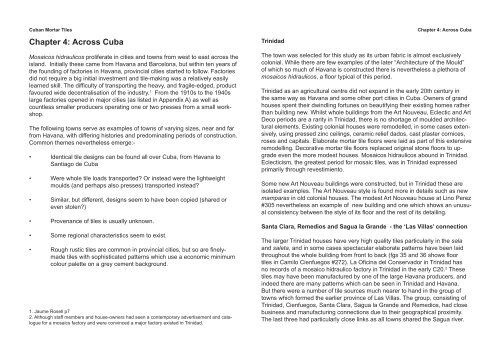Cuban Mortar Tiles - infogram.co.uk > Home
Cuban Mortar Tiles - infogram.co.uk > Home
Cuban Mortar Tiles - infogram.co.uk > Home
Create successful ePaper yourself
Turn your PDF publications into a flip-book with our unique Google optimized e-Paper software.
<strong>Cuban</strong> <strong>Mortar</strong> <strong>Tiles</strong><br />
Chapter 4: Across Cuba<br />
Mosai<strong>co</strong>s hidrauli<strong>co</strong>s proliferate in cities and towns from west to east across the<br />
island. Initially these came from Havana and Barcelona, but within ten years of<br />
the founding of factories in Havana, provincial cities started to follow. Factories<br />
did not require a big initial investment and tile-making was a relatively easily<br />
learned skill. The diffi culty of transporting the heavy, and fragile-edged, product<br />
favoured wide decentralisation of the industry. 1 From the 1910s to the 1940s<br />
large factories opened in major cities (as listed in Appendix A) as well as<br />
<strong>co</strong>untless smaller producers operating one or two presses from a small workshop.<br />
The following towns serve as examples of towns of varying sizes, near and far<br />
from Havana, with differing histories and predominating periods of <strong>co</strong>nstruction.<br />
Common themes nevertheless emerge:-<br />
• Identical tile designs can be found all over Cuba, from Havana to<br />
Santiago de Cuba<br />
• Were whole tile loads transported? Or instead were the lightweight<br />
moulds (and perhaps also presses) transported instead?<br />
• Similar, but different, designs seem to have been <strong>co</strong>pied (shared or<br />
even stolen?)<br />
• Provenance of tiles is usually unknown.<br />
• Some regional characteristics seem to exist.<br />
• Rough rustic tiles are <strong>co</strong>mmon in provincial cities, but so are fi nely-<br />
made tiles with sophisticated patterns which use a e<strong>co</strong>nomic minimum<br />
<strong>co</strong>lour palette on a grey cement background.<br />
1. Jaume Rosell p7<br />
2. Although staff members and house-owners had seen a <strong>co</strong>ntemporary advertisement and catalogue<br />
for a mosaics factory and were <strong>co</strong>nvinced a major factory existed in Trinidad.<br />
Trinidad<br />
Chapter 4: Across Cuba<br />
The town was selected for this study as its urban fabric is almost exclusively<br />
<strong>co</strong>lonial. While there are few examples of the later “Architecture of the Mould”<br />
of which so much of Havana is <strong>co</strong>nstructed there is nevertheless a plethora of<br />
mosai<strong>co</strong>s hidrauli<strong>co</strong>s, a fl oor typical of this period.<br />
Trinidad as an agricultural centre did not expand in the early 20th century in<br />
the same way as Havana and some other port cities in Cuba. Owners of grand<br />
houses spent their dwindling fortunes on beautifying their existing homes rather<br />
than building new. Whilst whole buildings from the Art Nouveau, Eclectic and Art<br />
De<strong>co</strong> periods are a rarity in Trinidad, there is no shortage of moulded architectural<br />
elements. Existing <strong>co</strong>lonial houses were remodelled, in some cases extensively,<br />
using pressed zinc ceilings, ceramic relief dados, cast plaster <strong>co</strong>rnices,<br />
roses and capitals. Elaborate mortar tile fl oors were laid as part of this extensive<br />
remodelling. De<strong>co</strong>rative mortar tile fl oors replaced original stone fl oors to upgrade<br />
even the more modest houses. Mosai<strong>co</strong>s hidrauli<strong>co</strong>s abound in Trinidad.<br />
Eclecticism, the greatest period for mosaic tiles, was in Trinidad expressed<br />
primarily through revestimiento.<br />
Some new Art Nouveau buildings were <strong>co</strong>nstructed, but in Trinidad these are<br />
isolated examples. The Art Nouveau style is found more in details such as new<br />
mamparas in old <strong>co</strong>lonial houses. The modest Art Nouveau house at Lino Perez<br />
#305 nevertheless an example of new building and one which shows an unusual<br />
<strong>co</strong>nsistency between the style of its fl oor and the rest of its detailing.<br />
Santa Clara, Remedios and Sagua la Grande - the ‘Las Villas’ <strong>co</strong>nnection<br />
The larger Trinidad houses have very high quality tiles particularly in the sala<br />
and saleta, and in some cases spectacular elaborate patterns have been laid<br />
throughout the whole building from front to back (fgs 35 and 36 shows fl oor<br />
tiles in Camilo Cienfuegos #272). La Ofi cina del Conservador in Trinidad has<br />
no re<strong>co</strong>rds of a mosai<strong>co</strong> hidrauli<strong>co</strong> factory in Trinidad in the early C20. 2 These<br />
tiles may have been manufactured by one of the large Havana producers, and<br />
indeed there are many patterns which can be seen in Trinidad and Havana.<br />
But there were a number of tile sources much nearer to hand in the group of<br />
towns which formed the earlier province of Las Villas. The group, <strong>co</strong>nsisting of<br />
Trinidad, Cienfuegos, Santa Clara, Sagua la Grande and Remedios, had close<br />
business and manufacturing <strong>co</strong>nnections due to their geographical proximity.<br />
The last three had particularly close links as all towns shared the Sagua river.



